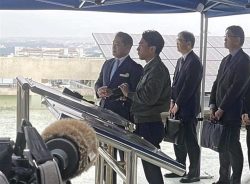
The first issue of the Sao Paulo Shimbun in October 1946.
12:45 JST, December 29, 2021
SAO PAULO — The Nikkey Shimbun published its final issue this month, bringing an end to the last Japanese-language newspaper in Brazil, the home of the world’s largest community of people of Japanese descent.
There was no other choice amid the declining number of people there who can read Japanese, but a new media outlet has been launched to keep the tradition of Brazilian Japanese newspapers alive.
Keeping the flame
Visiting Liberdade, an Asian neighborhood in Sao Paulo, it was easy to forget I was on the other side of the world from Japan.
On a street lined with suzuran-shaped street lamps and a vermilion o-torii gate, there’s a set meal restaurant where you can order in Japanese. A man I passed on the street was wearing a Chunichi Dragons baseball cap.

The final issue of the Nikkeiy Shimbun on Dec. 18 (online edition)
The head office of the Nikkey Shimbun was also in this neighborhood.
Published five days a week from Tuesday to Saturday, each issue had about six pages and cost six reals (about ¥120). It earned revenue mainly from subscriptions, unlike free papers that profit from advertising. The Nikkey Shimbun was available by delivery, in shops and online.
In addition to political and economic news from Japan and Brazil, it contained information about events of interest to the Nikkei population and haiku poems submitted by readers.
The final issue on Dec. 18 featured a column on page two by editor-in-chief Masayuki Fukasawa, 56, titled “Goodbye, Nikkey Shimbun!” Expressing his gratitude to readers, Fukasawa said he had continued to publish Brazil’s last Japanese-language newspaper with a “sense of concern about ‘not being the one to let the flame go out.’”

Nikkeiy Shimbun editor-in-chief Masayuki Fukasawa (left) with President Raul Takagi in Sao Paulo on Dec. 7
In addition to its aging readership, the novel coronavirus pandemic dealt the paper another blow.
Declining circulation
As of 1949, Brazil had at least seven Japanese-language newspapers. Some shut down and others merged over the years, and by 1998 there was only the Nikkey Shimbun and the Sao Paulo Shimbun. The latter stopped publishing three years ago.
In 1908, the Kasato Maru entered Santos Port outside Sao Paulo, carrying the first 781 Japanese immigrants to Brazil.
Despite a prolonged interruption due to World War II, about 250,000 people have crossed the sea since then. According to Japan’s Foreign Ministry, there are more than 2 million Nikkei in Brazil, some of them sixth-generation.
As new generations take over, fewer can read, write or speak Japanese.
About 10 years ago, the Nikkey Shimbun began putting phonetic kana above kanji characters.
“In the old days, we’d have been flooded with complaints telling us ‘not to do unnecessary things,’” President Raul Takaki, 75, said with a wry smile.
The paper’s declared circulation right before it closed was about 10,000 copies. However, in truth it was down to thousands.
Victory-defeat
“Japanese newspapers and the Nikkei community are inseparable,” stressed Renato Ishikawa, 83, chairman of the Sociedade Brasileira de Cultura Japonesa e de Assistencia Social, a Brazilian Japanese cultural society.
For the first generation of immigrants, who were not fluent in Portuguese, newspapers in Japanese were a valuable source of information.
In the 1910s, newspapers with names like Nippaku Shimbun and Burajiru Jiho started to appear.
But when President Getulio Vargas came to power in a military coup in 1930, he pushed for the assimilation of immigrants. The teaching and use of Japanese was prohibited, and in 1941 all Japanese-language newspapers were shuttered.
Japan attacked Pearl Harbor in December 1941 to start the war in the Pacific, and the following year Brazil severed diplomatic relations with Japan. The only information Nikkei immigrants could obtain in their native language was through shortwave broadcasts from Imperial headquarters on “Radio Tokyo,” which they listened to in secret.
Many Nikkei thought the information published about their homeland in Brazilian newspapers was disinformation spread by the Allied powers.
After the war, this led to a dark period in the history of Brazil’s Nikkei community known as the “victory-defeat conflict,” in which people who believed Japan had lost the war fought with those who did not. There were even extremist attacks with fatalities and at least 23 people were killed on both sides.
“If there had been Japanese-language papers during the war, at least some accurate information could have been conveyed and the situation might have been different,” Ishikawa said.
Save the light
Among the Japanese-language newspapers that were founded after the war, some were associated with the “victory” faction and others with the “defeat” faction. They waged their battles in print, though sometimes journalists were in physical danger.
The Paulista Shimbun, founded in 1947, and the Diario Nippak, founded in 1949, merged to become the Nikkey Shimbun in 1998. Both belonged to the defeat faction.
The paper’s stated editorial policy was “To not forget the historical legacy of our founding goal to bring to a close the period of turmoil the Nikkei community experienced in the postwar period.”
“Conveying accurate information is in our DNA,” Fukasawa said proudly.
The history of the Nikkey Shimbun has now ended, but the role entrusted to Japanese-language newspapers by the Brazilian Nikkei community will continue with the help of Japanese investors.
The Diario Brasil Nippou is scheduled to launch on Jan. 4, published by a newly established non-profit organization chaired by Takaharu Hayashi. The publication will employ six Japanese-language reporters from Nikkey Shimbun, including Fukasawa.
There will be both paper and online editions. In a bid to achieve stable business performance, there will be more information on Japanese residents of Brazil and Nikkei residents of Japan. A Portuguese weekly is also planned.
Hayashi, 71, ran a staff dispatch company in Japan for many years, and has interacted with the Nikkei community in Brazil through the descendants of Nikkei immigrants who came to Japan to work.
At a celebration commemorating the founding in Sao Paulo in late October, he said, “We can’t let the torch of Japanese newspapers in Brazil go out.”
Tadao Ebihara, 72, who is in charge of the endeavor locally, said this would be “the last big task in my life.”
Trying to survive
The declining number of people who can read Japanese is a common problem faced by Japanese-language newspapers around the world.
In the Americas, where Japanese immigrants have a long history, newspapers are trying to figure out ways to survive.
Daisuke Tomaru, 44, chief of the Japanese editorial department of the Peru Shimpo, which was launched in Peru in 1950, said the paper faces the sad reality that “whenever a first-generation Nikkei dies, our circulation goes down by one.”
Nevertheless, a few years ago they launched a project to present Peruvian news in easy-to-read Japanese aimed at Japanese language learners, which has proved popular and helped maintain their circulation.
The Hawaii Hochi, which was first published in Hawaii in 1912, posts free videos on YouTube in which the news is read aloud in Japanese. They also put out a children’s newspaper to appeal to a broader section of readers.
According to an association of overseas Nikkei newspapers and broadcasters headquartered in Yokohama, the number of Japanese-language newspapers in the Americas has declined from about 20 around 1980 to seven.
Executive director Mamoru Okano, 67, said: “Japanese-language newspapers are the history of the Nikkei community and a bridge with Japan. If they can’t publish daily, I hope they’ll continue as weeklies. I want the existence of Japanese-language newspapers to be more widely known, even in Japan.”
"World" POPULAR ARTICLE
-

U.S. Senate Resolution Backs Japan, Condemns China’s Pressure
-

China to Impose Sanctions on Shigeru Iwasaki, Former Head of Japan’s Self-Defense Forces, Who Serves as Adviser to Taiwan’s Executive Branch
-

Chinese Foreign Ministry Criticizes Japan’s Largest Ever Defense Budget in Draft Budget for Fiscal 2026
-

China Appears to Warn Japan, U.S. with Drills Around Taiwan
-

China Confirmed to Be Operating Drilling Vessel Near Japan-China Median Line
JN ACCESS RANKING
-

As Chinese Tourists Shun Japan, Hotels and Stores Suffer
-

Tokyo Economic Security Forum to Hold Inaugural Meeting Amid Tense Global Environment
-

Osaka-Kansai Expo’s Economic Impact Estimated at ¥3.6 Trillion, Takes Actual Visitor Numbers into Account
-

BOJ Gov. Ueda: Highly Likely Mechanism for Rising Wages, Prices Will Be Maintained
-

Japan Govt Adopts Measures to Curb Mega Solar Power Plant Projects Amid Environmental Concerns























